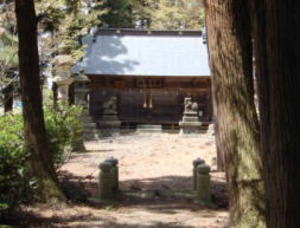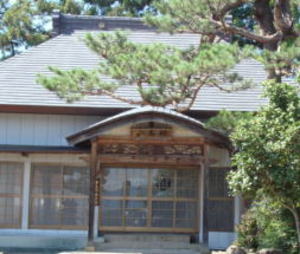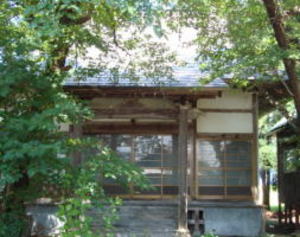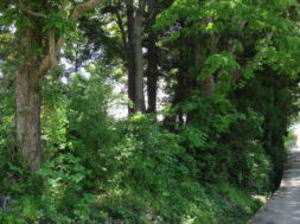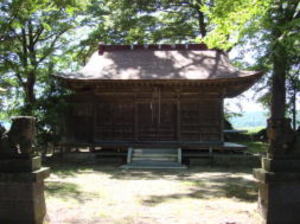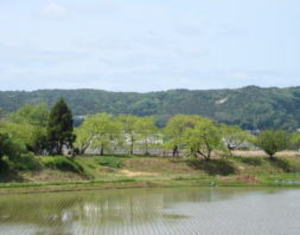was rebuilt in The Meiji 21 year(1888 year, when Rokumeikan diplomatic was gorgeous) and continued to the present day.
There is a Taishi-dō hall in the precincts, and the Prince Shōtoku filial
piety statue is enshrined. The feast day of the Taishi-kō
(Prince lecture) is August 22.
The original Fukuhara settlements was a riverbed of the Tsurunuma-gawa
river. In the Shiro-Hige-no-Ōmizu(the big flood of
the white beard) of Tenbun 5 year (1536 year, Muromachi period), it was a village which can be made by reclaimed the
common name Fukukawahara of the wasteland of the mark that the main stream
moved to Ō-kawa river (Aga-kawa river).
In Shin-Pen-Aizu-Fudoki
the Kimoiri is Saze Kazaemon is reported. It is the founder of the Saze family who set up a splendid
Nagaya-mon gate in the village now.
In the precincts,
there is the Gorinto tower tomb of the Sumo wrestler's professional name
Tamasudare of Aizu.
In the past, elementary and junior high schools, the local police station,
the branch post office were set up in the center of
Kanagami district.
When it merged
with Aizu-Bange town, the local police box and the branch post office were
integrated to Aizu-Bange too.
(Welcome map Aizu Bange town East
area map)
it became
independent getting authorized by Fukushima prefecture and renamed Jizō-ji temple.
In the Shinpen-Aizu-Fudoki, "It was in the place of the north 8-Chō(0.9km) in the village before, and it retured to this place on
February 29, of Keichō 19 year(1614 year). It is said.
The before was in the place of the north about 0.9 km in the village, after
being swept to Echigo Kunimatsu-ga-zaki (now Niigata Airport Area, Niigata
prefecture) by the big flood of the Shirohige (big flood of white beard)
of the Tenbun 5 year (1536 year).
In Keichō 19 year (1614 year, the year of the Aizu big Earthquake), it
is said that the statue of Jizō-Bosatsu was rebuilt in its
current location after it was the wake of the returned. The Jizō-Bosatsu
statue has been designated as an important cultural
property in Aizu-Bange town. As a Koyasu-Jizō (Jizō for children’s health),
we are collecting the faith of local residents.
Saikuna settlements is, in Daidō 1st year (806 year) when Mt. Bandai erupted
and upheave, Lake Inawashiro subsidence (Aizu-
Onko-Jyūyōshō). It is said that there was a village name of "Saikuna"
in the village where 49 villages sank in the bottom of the
lake, too. It is said that the villagers who evacuated from there pioneer
the area and created the village.
The resident who
was cleaning the precincts taught me that there was such a legend of Mr.Jizō.
Mr. Jizō carried a
wicker trunk on shoulder, in Aizu-Bange storytellers version…,
The end of the Kamakura period (Kagen years, 1303 year ~ 1306 year), the Nisson the founder of a temple the Jisshō-ji temple
of Kurokawa (old name of Aizu-Wakamatsu city), was return from Dewa country
(Yamagata prefecture) approached Kumakura
village (Kumakura town, Kitakata city), Yama county, and then out of nowhere
a Buddhist monk boy appeared. And the Buddhist
monk boy was talked to Mr. Nisson. "People
in my village are suffering from disease. Please, save peoples from disease
with the
mystical power of Mr. Buddhist monk." to said. The Buddhist monk boy carried the
wicker trunk of Nisson on the shoulder, and
when came to the front of a certain a hermitage, the Buddhist monk boy
did the best to thanks for Nisson and went to somewhere.
Mr. Nisson was think to suspicious, when he asked owner of hermitage,
"There is no Buddhist monk boy in my house. but,
because there is a spirituai statue of the Jizō, it might be the incarnation."
because it says, when they walked into Jizō-dō, it will
be what thing! It is Mr. Jizō carrying the wicker trunk of Mr. Nisson
on the shoulder. Mr. Nisson was impressed, in response to
the request of the owner of hermitage, write the Nichiren prayer on the
back of Mr. Jizō, he also wrote the five characters
of "Myō-Hō-Ren-Ge-Kyō" on the stone monument, and did the law of disaster
to except out. And then, it is said that the suffering
of all the people of this village has been removed. Ohhh~! Thank Heavens!
Thank Heavens! (palms)
A stone monument with carved the Nichiren prayer of "Myō-Hō-Ren-Ge-Kyō",
which is said to have been written by Nisson in
the front yard of Jizō-ji temple, is still enshrined in wonder-warking.
The Mr. Jizō here seems to have been widely believed by
the people of neighboring countries, in the Shiro-Hige-no-Ōmizu (big flood of white beard) of Tenbun 5 year (1536 year, the end
of Muromachi period), it was swept away far to Echigo Kunimatsu-ga-zaki
(Niigata prefecture, area where Niigata Airport is
located). But about 80 years later, Keichō 19 year (1614 year) in the
early the Edo Period, was the children of the villages along
the road, it is reported that the episode that it was delivered to here
while sendihg in to the villages by putting it on the
wheelbarrow. The Sea of Japan near Niigata city in ancient times approaches the inland part more than now, the Agano-gawa
river (Aga-kawa river in Fukushima prefecture) it was join the Shinano-gawa
river near the estuary of the river, formed a vast
estuary area and wetlands. In the Meiji period the river separation work
was carried out, and it became a present basin. Echigo
Kunimatsu-ga-zaki was the port town of Agano-gawa river (Aga-kawa river in Fukushima prefecture) Water-transportation-port,
and it was the entrance to Aizu on the Sea of Japan side. The Jizō was
drifted somewhere in the wetlands, if it had not been for
it, it would have flown into the sea and gone missing.
Super lucky the Mr.
Jizō, isn't it?
Wicker trunk is explained that it is a suitcase that say now, but in fact it is a box with a lid made by knitting bamboo, willow,
and wisteria. It was widely used until the Shōwa 40's(1965s), such as luggage
and clothing storage at the time of travel.
It is no longer circulation with the westernization of traveling outfit
and changes in storage form.
It is the extent to which it is seen in "the Akeni (clothes box of
Sumō wrestler, a Sumō wrestler’s loincloth, an Ornamental
apron, and Yukata, etc. are put)" of the Sumō wrestling now.
(Welcome map Aizu Bange town East
area map)
Buddhism, it is the one that it was used for missionary work to the people
who cannot read the character. There is also a Engi-
Emakimono (a picture scroll depicting the stories) as other means of missionary
work. The east side of the main hall is Jizo-ji
temple (Jizo-Do hall). According to the Aizu-Kuji-Zakko, in Kagen 2 year
(1304 year), because there is a Tayu-Ajyari Nisson on
the Kurokawa (old name of Aizu-Wakamatsu city) to build a Kuonzan Jissho-ji
temple, it is thought that the founded of Myofuku
-ji temple to same time too.
The origin the old name the Kurokawa of Aizu-Wakamatsu city, the sulfur
content of hot spring water flowing from
Higashiyama Onsen (hot springs) it is told that it looked black by chemical
reaction with the mineral content of the river water.
There is a Jizo-ji temple in the precincts, in the Aizu-Fudoki as a legend of Jizo, the Jizo statue was swept away by the Shirohige
-no-oomizu(big flood of the white beard) of Tenmei 5 year (1536 year),
and "It went to Echigo country, and Keicho 19 year(1614
year) it came back to this place."
It seems to have gained the faith of the peoples widely not only the Saikuna
settlements. The Jizo statue is introduce in the
article "Jizo-ji temple".
(Welcome map, Aizu Bange town East area map)
The Izanagi-no-mikoto is returning from the Yomi-no-kuni (nether world of Japan myth), the God who made the change from
his nose when purification ceremony. It is the god of presides over the agricultural promotion and the Plague except.
Susano-o-no-mikoto is being mischievous in Takama-ga-hara, Amaterasu-o-mikami(the
Sun Goddess) hid in the Ama-no-Iwato
(Cave of heaven) the incident caused the frowned upon of other gods to
be expelled, and to destroy Yamata-no-orochi(eight-
headed giant snake), and it is a god of a considerably complex personality written the Waka poem for the first time in Japan
history.
The father of the
Okuninushi-no-mikoto of the Daikoku-sama(Daikokuten), "Kusanagi(grass cut)-no-tsurugi(sword)" is
enshrined in the Atsuta Jingu of Nagoya city of Aichi prefecture in one
of three sacred treasures, in the sword that came out from
the tail of the Yamata-no-orochi that was defeated by the Susano-o-no-mikoto on the original "Ameno-murakumo-no-tsurugi"
also said, it was renamed "Kusanagi-no-tsurugi" transmitted to
Yamato-Takeru-no-mikoto later. "Yakumotatsu Izumo Yaegaki
Tsumagomi Yaegakitsukuru Sono Yaegakiwo (Clouds(Yakumo), actively opwelling covered the eightfold fence. It makes the
eightfold fence to have stay in the house. Great eightfold fence.)". This poem that comes out first from among the numerous poem
recorded in Kojiki, the poem from this Susano-o-no-mikoto is considered
the origin of the Waka(Japanese poem). "To protect my
wife, I'll make a fence over and over again. ", and t is the one
to written the calm and happy married life with the Kushinada
princess who helped from the destroyed the Yamata-no-orochi. By the way,
realistically speaking, the Amaterasu-o-mikami hid
in the Ama-no-Iwato the incident is a total solar eclipse phenomenon, the Yamata-no-orochi extermination means suppression
the iron manufacturing group of Izumo country (Shimane Prefecture) by
the Yamato government,
Gozu-Tenno is the god of the syncretization of Shinto with Buddhism, and
is a the Guardian deity of Gion-Shoja in the birthplace
of the Buddha of the India, and is called as the Gion-God. Gozu-Tenno
later synchronized with Susano-o-no-mikoto.
On the day of Tenno-sai(Tenno-feastival) to oblations two cucumber, and it is told that it does not become sick when the one
which received the exorcism is taken home and eat. It comes from the legend that the plague was settled, when offer cucumber
to
the god of drive away a plague Gozu-Tenno.
The Susano-o-no-mikoto is also the god of agricultural promotion, the same
godization with Gozu-Tenno from the country-
generated the old things with Princess Kushinada.
To make an offering a cucumber resembling a male symbol, it is called "Cucumber
Tenno Festival" in the festival of women to
wishing for the good match connection, the marital harmony, and the prosperity of descendants. The "Tenno Festival" in
Sukagawa city of Fukushima Prefecture, is also says as "Yukata Tenno-sai(Yukata
Tenno Festival)", this day is also famous as a
festival of girls Yukata debut.
The origin of the name of the Zaru-yashiki settlements, is said to have
been supply "Zaru (bamboo colander)" to use in the
Takadera that the monk of the Chinese Liang country which was in the Takadera mountain opened.
Previously, this
region was collectively called "Funakoshi".
(Welcome map, Aizu Bange town North-West area map)
in the related offices and construction personnel who cut down the "O-Ise-no
Matsu(pine)"?
It's like "Yokoyama Inari" in "Dainomiya Park", and
it's like the curse of Amaterasu Okami. The Tsurunuma-gawa river flows
through the part of the rice field on the left of the photo, and until
the power development of the Meiji and Taisho periods
progressed, the salmon and the trout were run-up, and the Tsurunuma-gawa
river in the paddy part was done actively in
salmon, trout fishing, and river fish fishing. The present Tsurunuma-gawa
river flows further left of the rice field.
(Welcome map, Aizu Bange town North-West area map)
of the time was called a Mandokoro, the government office ruins of the Ninagawa-sho are considered to be arable land in the north of
Shimo-Mandokoro village. The period of Aizu reign of Mr. Ashina, it is said that the mansion called "Mandokoro-Yakata(mansion)"
was build.
When I was in junior high school time in Showa 37 year(1962 year), there
were excavated a lot of celadon jars and plates
from the ground which would have crossed from the Tang, Sung, Ming(each
were one country of old China) and Koryo(one country of
old Korean peninsula) when plowing the fields of the Shimo-Mandokoro. The one of my classmate who lived in the vicinity, it was
one that brought the jar and the plate of celadon and showed it.
The entire village is a hilly area surrounded by the Tsurunama-gawa river
and paddy fields, and it is a region the land which opened
out for a old time as like as the Aozu village. The village area of the Shimo-Mandokoro is a treasure trove of medieval ruins, where
full-fledged excavation and academic research is awaited.
Around the paddy of the area in the north of the settlements(photo), the
reeds field of the riverbed where the Tsurunuma-gawa river
(was in old time mainstream of Aga-kawa river) flowed in old time, in the Former 9 years war of Tengi 5 year(1057 year), Minamoto
-no-Yoshiie (also known as Hachiman-Taro Yoshiie) is battle formation
position in the dense fabric of reeds. At the end of the fierce
battle with the army of the Abe-no-Sadato side of this land, it is the
old battlefield that was a big victory to mopping up the Abe army.
It saw a disturbance in the line of wild geese flying over the reeds field,
and the righteous who realized that enemy soldiers were
lurking, say had the preemptive attack, the stage of the anecdote of "a
confusion in the flight of wild geese" is here. This win was the
trigger for the victory of the Expedition army of the role of the Former
9 years war.
The Shirohata
Hachiman Shrine of the south of the settlements, is the trace of the base
position of Minamoto-no-Yoshiie.
(Welcome map, Aizu Bange town North-West
area map)
Ninagawa-sho (which wrote it as Inagawa-sho) is, in Kyoto Yomei Bunko,
the "list of land property
of Konoe family" is a Reizei family territory. It has become clear
that time of the Emperor Sanjo
(reign 1011 year ~ 1015 year, the middle of Heian period), was a manor
of the territory of Reizei
-no-miya Princess Kenshi of the Sekkan-ke(Regent’s house). The Sekkan -ke (Regent’s house) is,
the house where the Sessho(Regent, a person who does politics on behalf
of the Emperor) and
Kanpaku (a person who is in control of bureaucrat) produced those important
bureaucrats.
The place name of Shimo-Mandokoro is, Tengi 5 year(1057 year, in combat of the Former 9 years
war) in the Todera Hachiman Shrine divine role list in place name of Shimo-Mandokoro.
The area of Ninagawa-sho(or called Inagawa-sho) is the range of the current
Aizu-Bange town,
Yanaizu town and Nishi-Aizu town. The place name the government office of the Shoen (manor)
Enshrined together is Emperor Ojin, Oyamazumi-no-kami, Konohana-sakuya-hime-kami. The feast day is on June 25.
The foundation is unknown. The local grand guardian gods of the old Aozu-group
(current Hirose district). At the subsidiary shrines
of Dewa country Haguro Shrine (Yonezawa city, Yamagata prefecture), it is one of two Hagurozan of Aizu together with Hagurozan
Toko-ji temple in Higashiyama district of Aizu-Wakamatsu city.
It was changed to Yui-itsu Shinto(One-and-Only Shinto) in the Enpo 3 year(1675
year) in which Mr. Hoshina Masayuki of founder
of Aizu clan had been reforming the feudal government. Until the end of
Edo period, it was called to as Haguro Gongen or Shijyu-
hachi-se(48 pond) shrine. In the past, wetlands spread around the area, and spring water also springs up abundantly, and there
were 48 swamps in the precincts and surroundings, and the trees were dense
and thickly. Even now, there is a swamps in front of
the front shrine of the precincts and called Kami(god)-numa(swamp), and
the large one is called Oya(parent)-numa(swamp), and
the other one called Kamado(cooking stove)-numa. It is that the Megusuri(eye-lotion)-numa was efficacy to the sickness of eyes.
But in modern times, please take a medical examination an Eye doctor to eye disease.
(Welcome map, Aizu Bange town North-West
area map)
Hirose shrine because it is in Hirose district? But it is not really...,
Hirose shrine is, it was founded in Emperor Sujin 9 year(BC 89 year), the
cheif main shrine is Hirose shrine in Kawai town,
Kita-Katsuragi county of Nara prefecture. Hirose shrine of Aizu-Bange town is does not understand the history of the transferring.
Because the Waka-uka-no-hime-kami is in main enshrined
the same as Nara Hirose Shrine, it seems to have been renamed
Hirose shrine from the divine virtues at the time of the ordinance distinguishing Shinto and Buddhism separation decree of Meiji
period.The current shrine building uses the granted material of Shikinen Sengu
of Ise Jingu Shrine. It is said that it carried by the
boat to the back of Shirohata shrine in Shimo-Mandokoro district from Ise Jingu Shrine, and moored to tie a boat with pine, brought
to this place and made to this ground and the renovation material.
In Hirose shrine, has this episode…,
A fine horse Ikuzuki is in Aizu-Bange-born, and Fight for the vanguard
in Uji-gawa river of Kyoto.
At the end of the Heian period, Minamoto-no-Yoshinaka(another name Kiso
Yoshinaka),who raised army overthrew the Heike
family in Shinano(Nagano Prefecture), entered Kyoto. But the military discipline is not dictated and works wildly with violence in
the capital Kyoto, and will soon conflicts with Minamoto-no-Yoritomo of
Kamakura (Kamakura City, Kanagawa Prefecture).
In Juei 3 year (1184 year), across the Uji-gawa river in the suburbs of Kyoto, the Kiso Yoshinaka army to confront the Kamakura
army led by Minamoto-no-Yoshitsune. At this time, Yoshitsune to raise the
morale of the military, the two warlords of the
subordinate to Sasaki-no-Shiro Takatsuna and Kajiwara-no-Genta Kagesue,
Uji-gawa river swollen with thaw water, which made
the competition can be passed by horse early.
The horse which two peoples were riding at this time, it was a horse that
had been ginen by Minamoto-no-Yoritomo in Kamakura
before the departure for the front, Sasaki Takatsuna's horse is Ikuzuki of fawn-colour and Kajiwara Kagesue’s horse is Surusumi
of black-colour, both were famous horses. The result of fight for the vanguard,
"Mr. Kajiwara, your horse's belly belt is loose." Sasaki
Takatsuna was won in the fake, excited about this the Kamakura army, led
by Yoshitsune, won the Battle of Uji.
This led the Kamakura army to seize the initiative of overthrow the Heike and lead to the fall of the Taira family at the next year
in Dan-no-Ura. It is told that it was a horse named Ikuzuki that Sasaki
Takatsuna was riding, and was a fine horse which appeared
from the Oya-swamp in Hirose shrine precincts. It is said that the spirit
of the Oya(parent)-swamp is Tsukige-no-Koma(milk-white
horse), and it seems to have produced a lot of famous horses from this area in old times, and horse's grazing was done in this region.
"Shogun Jizo" of the Jizo statue of the armed equestrian figure of posterity is said to model is Sasaki Takatsuna.
In addition..., this shrine is enshrined the goddess statue called "Maria Kannon". The statue is Gassho with a long flowing hair, a
figure like wearing a Uchikake, and the collar in left is single, the
right is triple. It is told that it is a sign of the Christian "Trinity".
It is not known why Maria Kannon is enshrined here. It is thought that
it originates because there was an ardent Christian believer
in a vassals in the Aizu reign of Mr. Gamo Ujisato who had the understanding
of Christianity.
It is said that there were three churches in the Bange village(current
Aizu-Bange town) at that time, but it is said that disappeared
immediately after the Prohibition decree was promulgation. Where were
the three places, and do not know at all in now.
No materials have been found too.
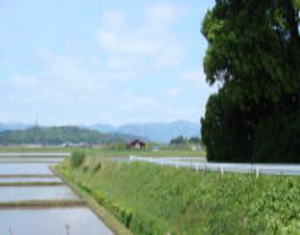
Hirose shrine
Located at the southwest tip of Fukuhara village on the opposite bank of
the Saimyōji-ferry
boat, east of Aizu-Bange town. According to the Shinpen-Aizu-Fudoki, the founded was,
Saze Kazaemon opens Fukuhara newly reclaiment rice field, village of Kawanuma
county
in Genna 9 year (1623 year, the year Tokugawa Iemitsu became the third Shōgun. At the
time of the 3th Generation Tadasato rule of the Aizu Gamō family, the
year Uesugi
Kagekatsu dies.), it said that in the same village, a Zen-sect(unknown
denomination) monk
Rin-etsu built Tokushō-ji temple. The principal Budha is statue of seated Amida-Nyorai.
The temple name is said to have been named after Saze Kazaemon Norimasa,
who founded
the temple. It seems to have been a magnificent temple at the beginning of it’s foundation,
but it was damaged by a fire in the settlements of Meiji 12 year (1879
year, the year of the
inauguration of Okinawa prefecture), and all but Principal Buddha were
burned down, it
The east end of Aizu-Bange town. In the feudal administration peroid there was a port of
ferryboat of Yonezawa-Kaidō road(to Yonezawa city, Yamagata prefectuere),
it is located next
on east to the Honkōzan Myōfuku-ji temple main hall is Jizō-ji temple
in Saikuna settlements
along the Ō-kawa river (Aga-kawa river). Principal Buddha is a wooden
seated statue of Jizō-
Bosatsu. The foundation of a temple is unknown.
The statue of Jizō-Bosatsu and the foundation of temple are older than
Myōfuku-ji temple, and
are thought to be before the Kagen years (1303 year ~ 1306 year).
It had been the sub temples of Myōfuku-ji temple for a long time. In Shōwa
28 year(1953 year).
Located at the east end of Aizu-Bange town, in the southern part of Saikuna
settlements along
O-kawa river (Aga-kawa river).
The Saikuna is, the place where there was a wharf of the Bange side of ferryboat of Sano on
Yonezawa-Kaido road in the feudal government period. They arrive and depart
the lading to
and from Wakamatsu castle town was headed from here to Castle town and
the Kaido route.
The Kagen years (1303 year ~ 1306 year, the end of Kamakura period), there
is the tradition
with the temple founded by Nisson in this area where was located in the Jizo-Do. Principal
Buddha is the Mandala. The Mandala is a Buddhist peculiar painting.
The Buddhist view of
the world is expressed in a painting. Also, some of the sects of the Japan
represent the
genealogy of the sect and its ancestors since the Buddha. In the dawning of each sect of Japan
floods repeatedly, and settled in the current location by repeated relocation.
The founded
year of the temple was unknown.
Originally first founded was the Soto sect, Kan-ei 2 year (1625 year, the
year of the completion of the Kan-ei-ji temple in Ueno,
Tokyo), the Shingon monk Nichiei was converted to Shingon sect after restoration.
Principal image is a seated statue of Dainichi
-Nyorai. Two attendants is Nyoirin Kannon and Koyasu Kannon are followed.
Aizu-Kagami and Shin-pen-Aizu-Fudoki principal image is written with Yakushi-Nyorai,
but when did Dainichi Nyorai become
a principal image and do not known what has become of the whereabouts
of Yakushi-Nyorai. Probably, it is thought that it was
washed away by the flood damage at the period when there was no embankment
in O-kawa river (Aga-kawa river). In addition,
there is one old Buddha statue that seems to be the original thing that
was founded. The hall beside the main hall is Jizo-Do.
In the Jizo-Do, it say that six fingers on the right hand enshrined the statue of Enmei-Jizo-Bosatsu (Life-Prolonging Jizo) very
rare appearance. It is thought that six fingers of the right hand are
probably based on the thought of the same Rokudo-Rinne
as Roku-Jizo (Six Jizos). Rokudo is Heaven, peoples, Shura, animal, demon, hell, from each of them to say that the Jizo save,
I try to heard the truth of the thing to the villager in the farm farming
in the field in front of the temple. In the story of the
villager, when we repaired the statue in the Edo period of our ancestors
from now six generations ago, the cabinetmaker was
asked to repair the place where there were five fingers originally, it's been told that added one finger on what did he thought.
Why don't ask to Busshi(the sculptor of Buddhist statues) for repairs,
it is not understood now whether to have asked the
cabinetmaker.
To this Mr. Jizo, this is a tradition says that transmitted from the Edo
period…, Shining Jizo night after night, in Aizu-Bange
Kataribe (storyteller) version.
Old things, it is said that there was a thing which shines by putting out
mysterious light every night in the bush outside the
village. It is said that as the rumor spread, the villagers were so much feared. At one night, it is said that a young man of power
boast took up the shining thing. And what, and it was a wooden Mr. Jizo!
It is said that the child's sickness was immediately
complete recovery when this Mr. Jizo is pilgrimage in wholeheartedly.
It is said that the villager calls the Enmei-Jizo (Life-
prolonging Jizo).
Strangely enough, there are six fingers on the right hand of this Mr. Jizo.
Do not know why it is six, but there is a special might
be said that Mutsu-Roku in popularly. It is said that it is only one in
Aizu-Bange town.
Such a story might have been created from the very heart of faith among the ancestors of the settlements, and it was handed
down long with the Jizo faith.
(Welcome map, Aizu Bange town East area map)
About 0.7 km of North of the Miyako district Murata settlements along Route 49. Located at
the west end of the Kutsugata settlements along the O-kawa river (Aga-kawa
river).
Tengi 5 year (1057 year, Minamoto-no-Yoshiie was the Todera Kokoro Shimizu Hachiman
shrine construction) in the Todera Hachiman Shinto priest list the "Kutsugata village"
because there is a place name, it can be said that it is a village opened from ancient times.
In the old days of this settlements, it was on the place of the current Lake Inawashiro.
At the time of the eruption of Mt. Bandai in Daido 1 year (806 year), when
this region has
collapsed and lake Inawashiro formed, the old Kutsugata village sank to
the bottom of the
lake with 40 several villages nearby. The peoples of the settlements took
refuge in Aizu basin.
It has been told that it has moved to the vicinity of Kyode village, but has suffered a flood of,
Shingon sect
Kokudozan Jyoan-ji temple
The back of the Shirahata Hachiman shrine in shimo-Mandokoro settlements is the site of
the boat wharf of the Mandokkoro, and there was a boat-connected pine
called "O-Ise-no-
Matsu(pine)" until the Showa 30s (1955s) when there was a ferry passing
between Yasaka
shrine in Funakoshi settlements on the left side (west) opposite side.
It is said that the name
came from the fact that the granted material at the time of the Ise Gingu
shrine Shikinen
Sengu ceremony was put on the boat, and it carried up here and connected
the boat to the
pine (around white guardrail). The pine tree was the time of field maintenance, "It's in the
disturbed of construction." and it is said that it cuts it down.
The granted material became
the renovation material of "Hirose shrine" introduced earlier.
I wonder if there was nothing
Ferryboat traces in
Sano
down by the fire in later years, and the present principal image is Shakamuni
Buddha. It is regrettable that it was a national
treasure or a important cultural properties class if it was a work image
of the Unkei.
The temple was originally in the south of settlement, and it was in the
place called "Matoba" which is a rice field now.
Matoba is the field of military practice field in the Middle period.
(Welcome map, Aizu Bange town East
area map)
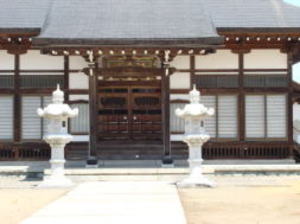
It enshrined in the Grove at the entrance of the Zaruyashiki settlements of Funakoshi village
on the opposite side of the Tsurunuma-gawa river which flows near Shirohata
shrine in the
Shimo-Mandokoro village.
It is the largest
shrine in Yasaka shrine in Aizu-Bange town.
Here is on the fluvial terrace of the Tsurunuma-gawa river.
Enshrined is Susano-o-no-mikoto, since ancient times, had been enshrined
synchronized with
the Gozu Tenno. The god of Yasaka shrine was also called as another name
the Tenno shrine
or the Tenno-sama. The feast day is July 15. The sohonsha(chief main shrine) is Yasaka
shrine in Higashiyama district of Kyoto prefecture, famous for its Gion matsuri(Gion festival).
Kitakata-Kaido road, it is a shrine which enshrined in the grove of about
250m to the right (east)
the signal of the intersection in front of Meguro Koji shop of Satobun
district.
Enshrined is also
called the Waka-uka-no-hime-kami, another name is Toyo-uke-hime-no-ookami
of the Ise Jingu
Gegu, and Fushimi Inari Shrine's Ukano-mitama-no-kami, and it is called
the Hirose-ooi-no-
kami and it is all the same God. The Ukano-mitama-no-kami is the guardian
of water, Toyo-uke-
hime-no-ookami is the Gozen-shin(a guardian deity of food) who protects
the food of all people,
Ukano-mitama-no-kami is the god in the preside over of bumper harvest, guarding disaster by
water, encouragement of new industry, river traffic safety, easy delivery
childbirth, and disaster-
removal and better fortune, there is a divine virtues in many fields.
Push the page bottan
Jōdo sect Fukujuzan Tokushō-ji temple
Nichiren sect Jizō-ji temple
Nichiren-Shoshu
Honkozan Myofuku-ji temple
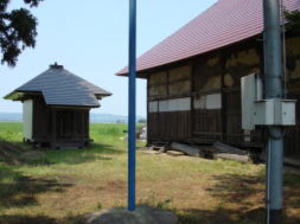
By the three-way road construction in Meiji 15 year(1882 year), the ferryboat
continued until Miyako-bashi bridge was
cross-linked to the O-kawa(Aga river).It was the rout to Wakamatsu castle town with the ferryboat of Takaku.
After the Aizu
large earthquake of Keicho 16 year (1611 year), it was used as the main
road of Yonezawa-Kaido road. The Takaku ferryboat –
Banga route had been used properly the Echigo-Kaido road.
The center of the photograph is Sano settlements. Near the building of
the red roof under the iron tower is, in Aizu-Koruiki,
the East and West 86-ken(156m), North and South 91-ken(166m) it was called
Kawarazaki-castle. Meitoku years(1390 year ~
1394 year, Southern and Northern dynasties period of Japan) Sano Shirozaemon
Miura Moritomo (one of Mr. Miura’s family )
it was written to build and live, the ruins of the medieval Mr. Ashina’s
chief vassal Sano family mansion.
The mountain in
the back of the photograph is Nekoma-dake mountain.
(Welcome map, Aizu Bange town East
area map)
About 1km downstream of Takaku ferryboat, in between the Saikuna settlement of the
opposite shore and the Kawanuma-county Yugawa village Sano district too, there was Sano
ferryboat in the Yonezawa-Kaido road in the feudal government period.From here, Miyako
district of Murata – Numakoshi – Aozu – Kitakata, is to reached Yonezawa(Yonezawa city,
Yamagata prefecture).In the early Edo period, Uesugi Kagekatsu was transferred to
Yonezawa (300,000 koku, equivalent to 10.2 billion yen in annual income)
from Aizu
(1,200,000 koku, equivalent to 40.8 billion yen in annual income), it is a road that passed
with Naoe Kanetsugu and many vassals of the Uesugi clan.

From Tsurunuma-bridge on Route 49 to Aizu-Wakamatsu about 0. 7 km, and turn to left the
signal in front of the JA (Japan Agricultural cooperative) Yotsuba (four-leaves)
Bange
Kanagami branch, it is located in the back (north) of the Kinagami-mansion
ruins of the Kanagami settlements of 0.5 km.
In the days of Takadera prosperity, it is said that one of the
36-Bo(priest’s house) of Takadera was in the place the Kinjo-Bo was. In
"Aizu-Nenpyo
(chronology)", in the Teiji 2 year (1363 year), Soto-monk Setsudo built the Shojuzan Kinjyo-ji
temple in Kawanuma-county Kanagami village. And it is said that enshrined
the Yakushi
statue of the work of Unkei. It became the Soto sect at this time. The
Yakushi statue was burnt
Soto sect Shojuzan Kinjyo-ji temple
After that, emigrate Morihiro the child of Fujikura (one of Ashina family)
Moritsune, in addition Keicho 4 year (1252 year)
Tsugawa-jyo castle (Tsugawa town, Higashi-Kanbara county, Niigata prefecture)
build it and moved. From the name of the
main domain where the offspring's Morihiro, named himself to Mr. Kanagami. The offspring of Mr. Kanagami is a residence
even now.
Mr. Kanagami is a brave family of successive armed battle group. As a lord
of manor of Kanagami for 15 generations until the
Moriharu after Morihiro served as Ashina family the regency, and the Lord
of Tsugawa-jo castle on served too.
Kencho 4 year (1252 year) ~ Tensho 17 year (1589 year, year of go to ruin of Ashina family in the Aizu invasion of Date
Masamune (Dewa country Yonezawa, current Yonezawa city of Yamagata prefecture)
for the 300 years, Mr. Kanagami worked
as an important post for the Ashina family as the regency.
Mr. Kanagami Moriharu was, Date Masamune at the time of the Aizu invasion, in the battle of Suriage-hara (plains) of the
base of Mt. Bandai, was killed in battle on Tensho 17 year(1589 year) June
5. The memorial monument of the Mr. Kanagami
Moriharu is build in the precincts of the Kinjyo-ji temple.
Date Masamune had orchestrated to conquer the Oshu(now Tohoku region),
on the use of the falling-out between the Ashina
head house and branch family of Mr. Inawashiro of Aizu, it is the one that it invaded to Aizu by ignoring the restraint of Mr.
Toyotomi Hideyoshi. The actual combat in the Suriage-hara is done by Mr.
Ashina and Mr. Inawashiro, Date was actively
support to Mr. Inawashiro without participating in the battle, it’s the
proxy war.
Kanagami village was also seen in the Todera Hachiman shrine divine role list of Tengi 5 year (1057 year), it is opened in the
center of the Aizu basin for a long time, and Mr. Ashina might have arranged
a powerful warlords as an important base in the
military side.
The Renga-shi (link-poemer) of the Warring states period of Japan, Inawashiro
Kensai is a person who came from Mr.
Inawashiro family and created the compendium of the Renga (link poem).The Renga(a link poem) is, to happen in Kamakura
period, successful in from the Southern and Northern dynasties period
to the Muromachi period, it is a kind of traditional
poetry of Japan. The syllable of 5-7-5 and 7-7 is the base while taking the form of continuous cropping by multiplayer, it is
established under the strong influence of the Japanese Waka (poem).
From the Haikai(the
Haiku group), the Renga and Haiku are derived from this later.
(Welcome map, Aizu Bange town East
area map)
It is about 0.7 km from Tsurunuma-bridge on Route 49 towards Aizu-Wakamatsu,
in addition
turn to left the signal in front of the JA(Japan Agricultural cooperative) Yotsuba (four-leaves)
Bange Kanagami branch in about 0.5 km of
the Kanagami settlements of Kanagami village.
The housing area surrounded by trees in the gate of the Shoju-zan Kinsho-ji
temple, the some
remnants of the moat and the soil base are left and the old times the
recalls.
According to
"Aizu-Kagami", after Kitada Jiro(Ashina Hiromori) was build
a mansion in the range of East-
West 75-Ken(23m), Ntrth-South 80-Ken(24m), and return to Kitada (current
Yugawa village
in Kawanuma county).
Kanagami-mansion
ruins
Yasaka shrine in
Funakoshi
Ferryboat traces of Mandokoro
The ruins of Ninagawa-sho government office
Simo-Mandokoro


